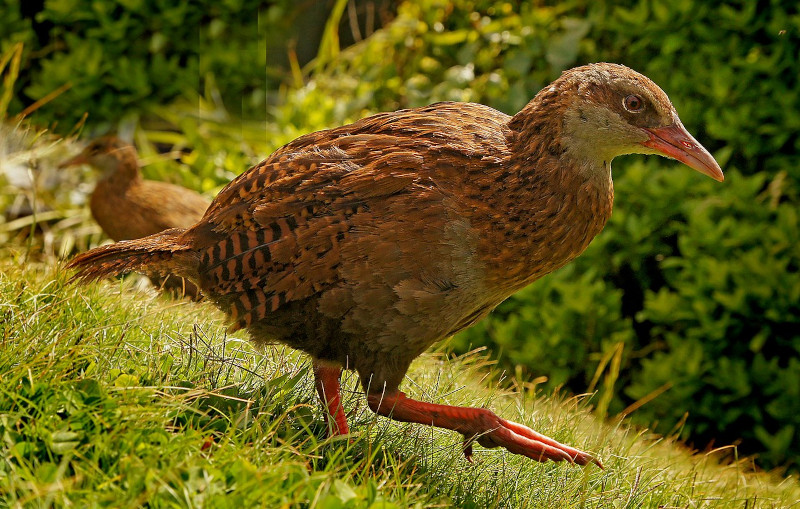
Weka Facts
- The deceptively simple term of Weka serves as the most frequently used common name for this intriguing product of evolution. Yet the remarkable avian also has other general titles, too. These include the epithets of woodhen or Māori hen.
- Within the scientific community, however, it’s perhaps better known by its technical title. As many such appellations go, though, that’s rather difficult for the layperson to pronounce. That’s because it bears the formal moniker of Gallirallus australis.
- The animal received that designation due to the efforts of Anders Sparrman. The respected Swedish naturalist, a student of Carl Linnaeus, accomplished the first recognition of it as a separate and distinct species. He managed that in the year 1786.
- No matter which label one chooses to use for it, the creature remains one worthy of note. This holds true due to several reasons. It represents the only surviving member of its genus, for one. Evidence indicates that between 2 -4 subspecies of the bird also exist.
- Unfortunately, the Weka possesses a population base that’s small in number. The balance it’s maintaining seems to be a delicate one, though. Due to these factors, the IUCN currently lists this animal as Vulnerable on its Red List of Threatened Species.
- Sadly, it faces multiple threats to its continued existence as a species. This includes such perils as predation by introduced species and habitat loss due to human actitivies. It also now faces the same danger of climate change that all earth’s must deal with.
Related Articles
Weka Physical Description
The Weka quickly captures the attention and appreciation of those fortunate enough to encounter it. Yet, this wonder of evolution does so for several reasons. It’s distinctive appearance certainly qualifies, of course. It’s also of respectable size for an avian of its type.
The creatures also follows an evolutionary pattern common to many animals. That’s in the fact that it displays a certain degree of the physiological characteristic known as sexual dimorphism. The gender-based difference manifests in terms of pure size, though.
Males develop as somewhat larger than the females on average. A mean-sized male attains a total length equaling approximately 20 – 24 in (50 – 60 cm). His mass varies across a wide range, however. This measurement averages between 1.17 – 3.54 lb (0.53 – 1.6 kg).
Females, meanwhile, remain slightly smaller in both categories. For them, the total length of an average-sized individual merely reaches 18 – 20 in (46 – 50 cm). Their mean masses also understandably vary accordingly. These range from 0.77 – 2.3 lb ( 0.35 – 1.04 kg).
Otherwise, though, the two sexes of the Weka present the same general appearance. The predominant background color of the feathers presents as a dark brown. Yet, it also displays a mottling of gray and black. The shades of each varies slightly between individuals.
Being flightless, its wings are quite short. These typically measure 20 – 24 in (50 – 60 cm). The bird’s further noted for its appreciable beak. Being relatively large, this develops as reddish-brown, roughly 2 in (5 cm) in length, quite sturdy, and tapered in design.
- Kingdom: Animalia
- Phylum: Chordata
- Class: Aves
- Order: Gruiformes
- Family: Rallidae
- Genus: Gallirallus
- Species: G. australis
Weka Distribution, Habitat, and Ecology
The tantalizing wonded simply named the Weka evolved as native to a very small portion of the surface of the globe. The location of that zone of habitation probably won’t surprise many people, though. That’s because it developed as endemic to what’s now New Zealand.
Previously, its range included parts of most of the islands of this nation. That once included the eastern part of South Island, but no longer. Presently, this lovely creature mainly resides on Chatham Island and Pitt Island. It’s also been recently introduced to other islands.
Fortunately for it, the bird evolved impressive flexibility in its choice of habitat. Due to that capacity, it inhabits a reasonably wide range of ecoystems. Natively, these include such diverse regions as areas of sub-alpine grasslands, rocky shores, sand dunes, and forests.
However, the versatile marvel also displays yet another characteristic that aids in its success. That’s the proven ability to adapt to human-modified environments. The avian therefore occasionally appears in sections of the islands that consist of semi-urban regions.
Like many of its kind around the world, the Weka evolved as omnivorous in nature. In its case, vegetative matter forms about 70% of its diet. This includes berries, seeds, grass, and leaves. Its animal prey includes invertebrates and frogs, rats, and even smaller birds.
Its breeding season varies, but, in good conditions, may include four broods per year! It builds its nests on the ground, under thick cover. Females generally lay 3 eggs, with hatching taking about one month. Both parents participate in the incubation and feeding of young.
Species Sharing Its Range
Check out our other articles on 5 Fabulous Mammals of Florida, Texas Blind Salamander, Blood Falls, Cheddar Pink, Great Barracuda, Alligator Snapping Turtle, Franklin’s Bumblebee
